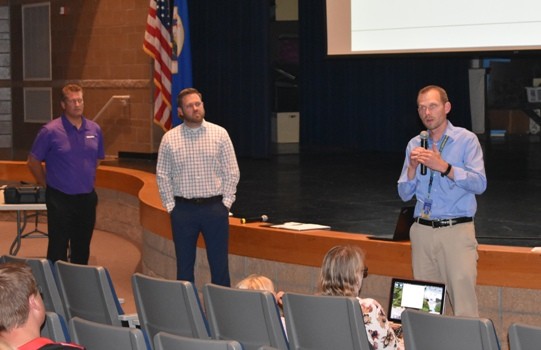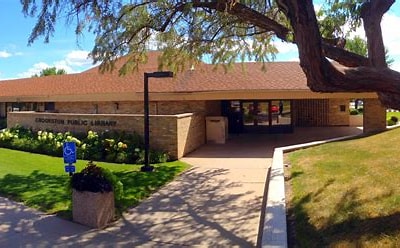The Crookston School District held a public meeting Thursday on the two referendum questions that will be on the ballot November 5. The first question is a repeal and replace of the operating referendum, which would lower taxes. The second question is to build a bus garage on the Highland School Property.
OPERATING REFERENDUM
The proposed operating referendum would decrease the current referendum by 9 percent removing the portion of the past referendum that was for operating the pool. The proposed referendum would lower the financial allowance per student from $604.51 to $523.10. Crookston also qualifies for state aid on the operating referendum. The state would pay 31 percent ($142.60) of the first $460 per student said Jodie Zesbaugh, a senior advisor with the district’s financial consultant, Ehlers. “The state has paid a portion of the operating referendum allowance for the district for a number of years,” said Zesbaugh. “The 2019 legislature increased the amount of state aid that is available. Crookston will qualify for the 31 percent of the first $460 of that allowance to be paid by the state.”
According to Zesbaugh property owners of seasonal recreational property don’t pay taxes on operating referendums thanks to legislation speared by former Governor Jesse Ventura. Agriculture owners are also only taxed on the valuation of their house, garage, and one acre of land. “For question one, the seasonal property owners don’t pay anything toward that question,” said Zesbaugh. “The ag property owners will pay on their house, garage and one acre not on any of their other land or buildings. That’s all that’s taxed. You don’t see that value on any of the tax statements provided by the county. So, if you’re interested in knowing that we can help get that information or the county can help provide that.”
Its estimated taxes would decrease between $10, for a home valued at $50,000, and $96 for a home valued at $500,000 if the referendum was passed. Commercial and industrial properties would also have the same decreases for those tax valuations.
BUS GARAGE REFERENDUM
On the bus garage question, Superintendent Jeremy Olson provided a background on the steps taken to determine what the bus garage committee felt was the best value for Crookston. Olson said he thought the committee did a great job of putting the focus on being as cost-effective as possible in designing the building. The proposed bus garage is a heated pre-engineered metal building with a second wood frame garage for the district cars for $2.9 million.
Allan Dragseth shared his experience on the committee about what he learned and how he would’ve bet a pole shed would be the cheapest option. “There were three farmers on that committee, Ralph Pester, Chris Cournia and I,” said Dragseth. “Right up until the last meeting I’d have bet you $1,000 that the pole shed would have come in cheapest. And it turned out to be the most expensive. This committee met I think five or six times. Several of us went to look at bus garage’s in Lake of the Woods, Northern Cass and Fertile. One of our problems is we live in Minnesota. When we went to the one in Northern Cass, I asked why don’t you have this or that. And they said remember we’re on the west side of the Red River not in Minnesota.”
Todd Blixt, the principal architect for ICON, also said the committee was very focused on cost. And they had the architects do everything they could to create a cost-effective but functional building. “The committee tasked us to focus on cost for the building and every little thing we could do to bring down the cost on the project,” said Blixt. “They pushed us to dig in and find those different options to save cost on everything from a double garage door vs. single garage door to the orientation of the building. It’s laid out the way it is right now to minimize the asphalt paving outside. All those things add up in the end. So, we went through trying to find out everything we could to save costs across the board and provide a building that is functional but is also cost-effective.”
Blixt took additional time to explain the decision for a heated building. He said one factor they considered was the electricity needed when buses are plugged in at zero degrees for eight hours over the winter against the cost of heating. “That was an interesting study that we did with the help our electrical engineer,” said Blixt. “We ran a calculation at the beginning for plugging in a bus every day for eight hours when the temperature is zero, and it takes a lot of watts to keep it up 40 or 45 degrees. You save a lot on the wear and tear as well.”
According to Blixt, a heated garage also allows for a wet fire suppression system which is cheaper than a dry system. “When you don’t heat the space you can’t have a sprinkler system that has water in it because it will freeze,” said Blixt. “So, what we have is a dry pipe system with no water. What happens is a smoke detector singles the smoke, and once it realizes the smoke detector is going off, it sets up and waits for a break in the line to happen. Once the air starts rushing out, a pump kicks in and fills the system with water. That system is a lot more expensive than a wet (standard) system. There is always water in there. It’s always hooked up and hooked to the city pressure system ready to go. It’s more cost-effective than putting in the other system. It was another factor playing into why not heat the space.”
The bus garage would raise taxes by $10 for a $50,000 home up to $159 for a $500,000 home. Commercial property would be raised $24 to $293 at the same tax valuation. Additionally, agricultural property taxes will be eligible for increased tax credits on question according to Zesbaugh. “For taxes payable in 18-19 that credit was 40 percent for the district’s debt service levies,” said Zesbaugh. “Anybody who has ag property would see that value of the credit, automatically deducted from taxes, in the upper right corner of the tax statement. That is going up to a level of 50 percent for taxes payable in 2020. Over the next couple of years, it will phase up to 70 percent.”
Zesbaugh explained that the tax credits are difficult to figure without specific information regarding agricultural properties. She did say that while tough to generalize if anyone contacted Ehlers, they would create a customized tax calculation. “If they go to the referendum section of the school website, our phone number and an email address will be listed,” said Zesbaugh. “So, whatever is the easiest way for you to get in touch with us. We’ll be happy to take a look at your specific situation and give you some customized tax calculations based upon your property.”
Additionallly Olson explained that a building that is built, bought or used by the district must meet current school building codes. Those codes are the most rigorous and costly, according to Olson. “There are three different code standards,” said Olson. “There is an ag standard which in more independent without a lot of specifics. In our research with the committee, it allows those buildings to be built at a lower cost. That’s because they don’t have the air handling requirements we do, fire suppression or those types of requirements. The next level up is commercial. And the third and highest tier is school construction. When you look at those three different levels, school construction is always going to be more expensive. That’s because it has the most rigorous codes and the greatest amount of life safety requirements that have to be built into that.”
Olson was asked if he had a wild guess on what the same building would cost if being built as an agricultural building. Olson said that he wants to make sure they have accurate information before making it public on the school website. “I was asked this same question earlier today,” said Olson. “We do hear from some of the ag folks that we can build this building at this or that. And why does this build cost $2.9 million?. We’re going to make a good faith effort to answer that question. But before we answer that question, we have to do some research to make sure we can articulate out those costs.”
[embeddoc url=”https://kroxam.com/wp-content/uploads/2019/07/Scanned_from_a_Lexmark_Multifunction_Product07-09-2019-183837.pdf” download=”all”]
Tags:




